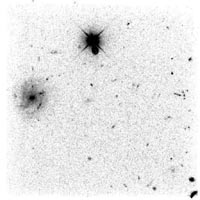
| Bad Astronomy |
|
|
|
BA Blog
|
|
Q & BA
|
|
Bulletin Board
|
| Media |
|
|
|
Bitesize Astronomy
|
|
Bad Astro Store
|
|
Mad Science
|
|
Fun Stuff
|
| Site Info |
|
|
|
Links
|
| RELATED SITES |
| - Universe Today |
| - APOD |
| - The Nine Planets |
| - Mystery Investigators |
| - Slacker Astronomy |
| - Skepticality |
Buy My Stuff

Keep Bad Astronomy close to your heart, and help make me
filthy rich. Hey, it's either this or one of those really
irritating PayPal donation buttons here.
The Parallel Universe II: Spiral Galaxy
Week of July 14, 1997Are you tired of me talking about STIS yet? I hope not! Once again, this is not exactly a bitesized snack, but more of a full course meal. I apologize for that to people looking for only a tidbit to look at, but this topic fascinates me, and I really want to share it with everyone!
The Space Telescope Imaging Spectrograph is one of the new instruments put on board the Hubble Space Telescope (HST) in February of 1997. One of the most interesting things we can do with HST now is the parallel program, which I outlined in a previous Bitesized Snack. Basically, while one camera on HST is pointed at some interesting target, the other two main cameras also take data, even though they are pointed somewhere else. These are called parallel images. Sometimes they have interesting things in them, and other times they don't. We get about a dozen images a day from STIS, so every now and then something pretty neat shows up.

I was looking through the parallels the other day, trying to find an image of an isolated star for an unrelated project. I found the image above (which, unfortunately, was not what I needed for my work). The image as it is shown here has been processed; it was originally six separate 150 second exposure images, which I added together and cleaned up a bit. The original picture I saw had only one of the images in it, and all I could see was the star at the top, and maybe a hint of a smudge on the left. Imagine my surprise when I added the images together and saw that smudge turn into a beautiful spiral galaxy!
This is a face-on spiral, and you can even see bright knots in the spiral arms. Those knots are probably vast regions of gas and dust that are forming stars. Just from the picture it is hard to know how far away that galaxy is, but I guess that it is about one billion (1,000,000,000) light years away. It is also a previously unknown galaxy! That means literally that either no one has ever seen it before, or someone saw it but never catalogued it. The former is far more likely, considering how faint it is. Just to give you an idea of how far away it is, it looks a lot like our own Milky Way Galaxy, which is about 100,000 light years across, yet is so far away that in apparent size, you could fit 200 of it across the face of the Moon!
On the right of the image you can see lots of faint blobs. Those are galaxies as well, but even farther away! I hesitate to guess just how far away they are, but it's safe to say that again these are previously undiscovered galaxies. You are looking at objects very few people have ever seen before. Incidentally, the weird circular shape just below and to the right of the star at the top is a simple internal reflection inside the optics of STIS, and is not a real object. It's the same sort of thing that makes so-called "lens flares" when you take a picture of a bright object with a handheld camera!
Now look to the very bottom right corner of the image. See that bright arc? I think that it is an arm of another, possibly brighter spiral galaxy. Unfortunately, with parallels, you don't get to pick where you point, so unless we happen to take another parallel in this region, which is very unlikely, we won't know what that object is. It's too bad, because it looks really interesting.
In the other Bitesized snack where I talk about parallels, the image I showed is mostly stars, with a couple of faint galaxies showing through. In this one, there is only a single star in the image, and everything else is galaxies. And this is only one small piece of the sky. A little math shows that STIS covers only about a two hundred millionth (0.00000002) of the sky, so if you take the number of galaxies seen here and multiply by 200 million, you'll get an idea of just how big the Universe is...
[DISCLAIMER: This page has absolutely no official affiliation with the Hubble Space Telescope, the Space Telescope Science Institute, NASA, or anyone else. It is my own doing, and I claim responsibility for all conclusions and mistakes made here!]
|
|
| THE PANTRY: ARCHIVE OF BITESIZE SNACKS |
|
|
| Subscribe to the Bad Astronomy Newsletter! |
| Talk about Bad Astronomy on the BA Bulletin Board! |